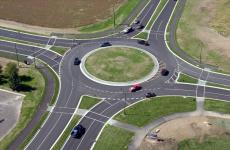Schemes for operational quality control of construction, repair and installation works. Download operational control schemes for the quality of construction, repair, construction and installation works Operational control schemes in construction
Regulatory documents regulating the quality of construction installation work, building materials, products and structures
Methods of testing and quality control of building materials, products and structures during construction and installation work
Part 1. Construction work
A. Earthworks
1. Development of excavations (trenches) for structures
2. Development of pits using excavators
3. Development of trenches for pipelines in non-rocky soils
4. Postback
5. Vertical layout
6. Construction of embankments
B. Construction of foundations
7. Installation of blocks strip foundations
8. Installation of wall blocks in the underground part of buildings
9. Installation of glass-type foundation blocks
10. Device pile foundations
11. Arrangement of prefabricated grillages
12. Installation of monolithic grillages
13. Installation of horizontal waterproofing of foundations made of cement mortars
IN. Concrete works
14. Installation of inventory formwork
15. Reinforcement work
16. Styling concrete mixtures
17. Construction of monolithic concrete and reinforced concrete walls
18. Construction of monolithic concrete and reinforced concrete columns
19. Construction of monolithic concrete and reinforced concrete foundations
G. Stone work
20. Wall masonry
21. Laying partitions
22. Laying pillars
D. Installation work
23. Installation of reinforced concrete columns of one-story buildings
24. Installation of prefabricated reinforced concrete columns of multi-storey buildings
25. Installation of reinforced concrete crossbars, beams, trusses
26. Installation of floor slabs and coverings
27. Installation of staircases and landings
28. Installation balcony slabs and jumpers
29. Installation of external wall panels frame buildings
30. Installation of panels, blocks load-bearing walls buildings
31. Installation of volumetric blocks of elevator shafts
32. Installation of prefabricated reinforced concrete ventilation blocks
33. Installation of volumetric blocks
34. Installation of sanitary cabins
35. Installation of gypsum concrete partitions
36. Installation of asbestos-cement extrusion panels and slabs
37. Installation of frame-sheathing partitions
38. Installation of walls from sandwich panels and sheet assembly
39. Welding installation connections reinforced concrete structures
40. Anti-corrosion protection of steel embedded products
41. Sealing joints
42. Caulking joints and seams
43. Construction of a garbage chute
E. Roofing and insulation work
44. Preparation of foundations and underlying insulation and roofing elements
45. Thermal insulation device from bulk materials
46. Installation of thermal insulation from slabs
47. Insulation device from roll materials
48. Insulation device made of polymer and emulsion-bitumen compositions
49. Roofing from rolled materials
50. Roofing from piece materials
51. Construction of a roof made of polymer and emulsion-bitumen compositions
52. Installation of a metal roof
G. Carpentry work
53. Installation of window blocks
54. Installation of door blocks
55. Construction of mezzanines, cabinets
H. Flooring
56. Preparation of soil foundations for floors
57. Construction of a concrete underlying layer, screeds
58. Floor soundproofing device
59. Installation of glued floor waterproofing
60. Device bitumen waterproofing gender
61. Installation of monolithic coatings
62. Installation of floors from ceramic tiles
63. Installation of mosaic floors
64. Installation of floors from polymer materials
65. Laying joists in floors on floor slabs
66. Laying logs on posts along soil foundation
67. Installation of plank floors
68. Installation of floors from piece parquet
69. Installation of floors from panel parquet
AND. Finishing work
70. Plastering works (simple plaster)
71. Plastering works (improved plaster)
72. Plastering works (high-quality plaster)
73. Plastering works (coverings from sheets of dry gypsum plaster)
74. Painting works(painting with water-based compositions)
75. Painting work (painting with waterless compounds)
76. Facing work
77. Wallpaper work
78. Glass work (glazing of bindings)
79. Glass work (installation of glass blocks and glass panels)
80. Installation of fiberglass fencing
81. Finishing (cladding) walls with panels, sheets with factory finishing
82. Montage suspended ceilings in building interiors
K. Improvement
83. Drainage device
84. Construction of a blind area made of concrete and asphalt concrete
85. Construction of sidewalks and paths from slabs
86. Construction of crushed stone base and asphalt concrete pavement
Part 2. Repair and construction work
1. Repair and strengthening of old foundations
2. Laying prefabricated reinforced concrete floor slabs during reconstruction brick buildings
3. Construction of monolithic sections in floors
4. Installation of floor slabs according to metal beams
5. Gain brick pillars and piers
6. Installation of metal jumpers
7. Installation of stairs on metal stringers
8. Device rafter system from wooden elements
9. Plaster repair
10. Repair of plastering of building facades
11. Painting facades
12. Installation of molded parts of facades
13. Installation of drainpipes
Part 3. Installation work
1. Making holes and grooves for laying pipelines
2. Installation of cast iron pressure pipelines
3. Installation of pressure pipelines from asbestos-cement pipes
4. Installation of internal cold and hot water supply pipelines
5. Installation of reinforced concrete and concrete non-pressure pipelines
6. Installation of sewer pipelines from ceramic pipes
7. System installation internal sewerage and drainage
8. Installation of water fittings
9. Installation of bathtub and washbasin
10. Installation of sanitary fixtures
11. System installation internal heating
12. Installation metal air ducts
13. Electric lighting device
14. Construction of round reinforced concrete wells
15. Installation of heating main cameras
16. Installation of non-passable channels
17. Insulation of heating pipelines
SCHEMES OF INPUT AND OPERATIONAL QUALITY CONTROL OF CONSTRUCTION AND INSTALLATION WORKS
Part IV, Issue 2
HEATING NETWORKS
GEODETIC WORK
GEODETIC WORK WHEN LAYING PIPELINES
TECHNICAL REQUIREMENTS
SNiP 12-01-2004 Organization of construction.
SNiP 11-02-96. Engineering surveys for construction. Basic provisions.
SP 11-104-97 Engineering and geodetic surveys for construction.
GOST R 51872-2002 Executive geodetic documentation. Execution rules.
SNiP 3.01.03-84 Geodetic work in construction.
A manual for geodetic work in construction (to SNiP 3.01.03-84).
Geodetic work when laying pipelines is mandatory integral part technologies for the production of pipeline laying works (self-control, operational control and acceptance control).
Geodetic control means, along with mechanical ones, provide the ability to lay pipelines in the design position (self-control), provide the ability to monitor compliance of the position of pipelines and its elements with design and regulatory requirements both during installation (operational control) and upon its completion (acceptance control by executive geodetic surveying the planned and altitude position of the laid pipeline).
Before starting work on pipeline laying, it is necessary to check:
Availability of PPGR, technological map and SOKK or as part of the PPR technological documentation to carry out geodetic work when laying pipelines, containing methods for performing detailed alignment work, a diagram of the location of signs, marks and landmarks, the order and volume of work performed;
Availability of a road layout certificate; the presence of an as-built drawing based on the results of staking out and fixing the places of connections and connections of communications, angles of rotation of the pipeline, wells, chambers, channels, tunnels, intersections of the pipeline with other networks;
Safety of signs of the external alignment network of the pipeline and axial signs, immutability of their position through repeated measurements of network elements; restoration of lost signs;
Availability of inspection certificates of previously completed earthworks for the construction of trenches and pits, certificates of acceptance of trenches and pits;
Availability of an as-built drawing (scheme) based on the results of a geodetic check of the compliance of the planned and altitude positions of trenches and pits with the design ones; the presence in the drawing of confirmation by the customer of the correctness of the preparation and compliance of the as-built drawing with nature;
Conducting training for workers on labor organization and methods for aligning pipes and other pipeline elements horizontally and vertically.
Controlled Operations | Composition and controls | Documentation |
Preparatory work | Check: Availability of PPGR, technological map and SOKK, or as part of PPR technological documentation for detailed alignment work when laying pipelines utility networks; | PPR, PPGR, technological map and SOKK |
Availability of an as-built drawing based on the results of staking out the pipeline route; | As-built drawing |
|
Preservation and invariability of the position of the pipeline network alignment signs, axial signs and signs that establish in nature the axis of the route, the beginning and end of the route, wells; restoration of lost signs; | General work log |
|
Availability of inspection reports of previously completed earthworks and the act of acceptance of trenches and pits; | Certificates of inspection of hidden work |
|
Availability of an as-built drawing based on the results of a geodetic as-built survey of completed trenches and pits with the customer’s permission to lay the pipeline. | As-built drawing |
|
Geodetic work when laying pipelines | Control: Compliance with the specified technology for geodetic work when laying pipelines; Accuracy of marking work; | Geodetic control log |
Laying pipes, wells, chambers, channels, tunnels in the design position (deviations in plan and height from the marks provided by the PPR using permanent and running sights, beacons, benchmarks, moorings, level, theodolite, laser devices). | Executive geodetic schemes |
|
Check: Compliance of the actual position of the pipeline and other structures with the requirements of the project and regulatory documents based on the results of instrumental geodetic survey; | As-built drawing |
|
Proper execution of the as-built drawing based on the results of the as-built survey and receipt of confirmation by the customer of the correctness of the as-built drawing in situ. | ||
INPUT AND OPERATIONAL CONTROL is carried out by: foreman (foreman), surveyor - in the process of work ACCEPTANCE CONTROL IS CARRIED OUT BY: foreman (master), representatives of technical supervision of the customer and operating organizations Instrumentation - level, theodolite, sights, wire, moorings, cast-offs, slats, measuring tape, laser devices, etc. |
Geodetic work when laying pipelines is an integral part of the technological process of work. They must be carried out in accordance with the requirements of SNiP 3.01.03-84, PPR, PPGR, operational quality control schemes and other technological documentation of the quality management system operating in the enterprise.
Before starting work on laying pipelines, the position of the pipeline axis must be secured.
The axis of the route is projected into the trench with a theodolite or a plumb line from a tensioned wire between the pivot points of the axis or turning points.
Fixing the position of the route axis, especially wells, can be done using castings, arranged on straight sections of the route at a distance of 40-50 m from one another, as well as at turning points. For cast-offs ( edged boards, attached horizontally to the pillars above the trench, or inventory engineering cast-offs) take out and fix the axes between which the string is stretched. From the string, the axis is transferred by plumb lines to the bottom of the trench.
Laying out the design slope of the trench bottom after completing shortfalls and making up for overshoots and breaking out the bottom of pits for sealing pipeline joints can be done using permanent (fixed) and running sights, geometric leveling, optical levels and laser slope clamps. Marks of permanent (fixed) sights attached to inventory cast-offs, or nailed to a wooden cast-off, or installed on the edge of a trench, are made by a level taking into account the design slope of the trench..jpg" height="17"> - design slope of the trench, DIV_ADBLOCK866">
Laying out the height of the bottom of trenches, pits and pits and relocating the pipeline axis using fixed and moving sights
https://pandia.ru/text/80/203/images/image005_11.gif" width="418" height="198 src=">
1. Fixed cast-offs 2. Running sights 3. Fixed sights on the edge of the trench
When monitoring using the method of geometric leveling along the axis, every 15-20 m, stakes are driven in, placed at a convenient distance from the axis, they are leveled and on each mark the depth of the trench is written, calculated from the difference between the design mark and the mark of the peg. The depth of the trench is controlled by a rod with centimeter divisions, along which the clamp and slider are mixed. The clamp is fixed at a mark equal to the depth of the trench from the top cut of the peg.
Automatic regulation of the trench depth can be performed using various slope sensors installed on the earth-moving machine (pendulum, electronic level, gyroscope) or using slope sensors installed parallel to the route axis separately from the earth-moving machine (string, laser light beam).
Laying out a well pit includes securing the center of the well, installing a cast-off fixed at a distance of 0.6-0.7 m from the edge of the trench, and transferring marks and axes to the cast-off.
Laying pipes in height can be carried out:
When building on a prepared foundation (by beacons) according to the level;
Schemes of incoming and operational quality control of construction and installation works. Part I, issue 2. Installation of prefabricated reinforced concrete structures of residential buildings, installation of light enclosing structures. Trust "Orgtekhstroy-11" 2001
Schemes for incoming and operational quality control of construction and installation works are drawn up in accordance with the requirements of SNiP 3.01.01-85* “Organization construction production».
Schemes of incoming and operational control are intended for line engineering and technical workers, foremen and workers, employees of the quality control department of construction and installation work, workers of laboratory, geodetic and welding services who carry out self-control, incoming, operational and acceptance quality control of construction and installation work.
Schemes can be used:
- employees of services for the preparation of construction production as standard ones for their inclusion in projects for construction and installation work or the development on their basis of schemes that reflect the specifics of specific projects of buildings and structures;
- employees of personnel training services as teaching aid in training, retraining and advanced training of workers and engineers;
- teaching staff of higher and secondary technical educational institutions in the training of engineering and technical workers construction profile;
- heads of departments, main functional departments and services, as well as management of construction organizations when testing knowledge of projects and regulatory requirements on the quality of construction and installation work performed by line personnel, as well as during inspection quality control of construction and installation work;
- employees of design supervision of design organizations;
- employees of the customer’s technical supervision who accept the work performed, employees of architectural and construction supervision services, federal and regional centers for licensing construction activities and other organizations supervising construction.
Schemes for incoming and operational quality control of construction and installation works are drawn up based on the requirements of building codes and regulations, state standards, technical specifications, standard design documentation and contain:
- basic requirements for the quality of materials, structures and parts used;
- list of technological operations subject to control during construction and installation work;
- a list of technical requirements that must be observed when performing construction and installation work;
- diagrams of the main assembly units;
- basic quality requirements for acceptance of completed stages and types of work.
Building structures, products, materials and engineering equipment arriving at the construction site must undergo entrance control. Work producers (masters) are required to check by external inspection and execution necessary measurements compliance of the quality of incoming structures, products, materials and engineering equipment with the requirements of working drawings, state standards, and technical specifications.
When performing incoming inspection at picking bases, the foreman (foreman) must be presented with documents (passports, certificates, acts, etc.) confirming the quality of the supplied materials and products. If there are any doubts about the quality of the supplied materials, the foreman (master) is obliged to request a control check of the received product materials.
Incoming control must prevent the launch into production of materials, structures and products that do not meet the requirements of design and regulatory technical documentation. On construction site Incoming inspection must be carried out by a foreman or foreman, with the involvement, if necessary, of laboratory and other services.
Operational control should be carried out during construction and installation work and ensure timely identification of defects and the causes of their occurrence, as well as timely adoption of measures to eliminate and prevent them.
When implementing operational control, the following must be checked:
- compliance with the work production technology specified in work projects and technological maps;
- compliance of the quality of work performed with the requirements of the project and regulatory and technical documentation.
Operational control must be carried out by the work foreman (foreman), engineer (laboratory assistant) of the construction laboratory, surveyor, welding service worker or welding laboratory worker. The participation of a particular service in the implementation of operational control must be regulated technological map to a specific process.
Acceptance inspection should be carried out upon completion of stages or individual species works, as well as critical structures. Acceptance is formalized by acts of inspection of hidden work, acts of acceptance of individual stages or types of work, as well as critical structures.
Acceptance must be carried out by a foreman, employees of the quality control department for construction and installation work, with the involvement, if necessary, of employees of laboratory, geodetic or welding services, and representatives of the customer’s technical supervision.
When carrying out production control, you should use measuring instrument and instruments that have passed metrological verification in established deadlines.
References to normative literature are given as of December 25, 2000. Data on the new regulatory documentation and changes to the current one are given in the information indexes of Gosstandart and Gosstroy of Russia.
Explanatory note.
Installation of reinforced concrete structures of residential buildings.
Off-site and on-site preparatory work.
Construction of a geodetic alignment basis for construction.
Construction of ground rail crane tracks.
- general technical requirements.
- geodetic work during the construction of ground rail crane tracks.
- requirements for operation.
Incoming quality control of prefabricated concrete and reinforced concrete products and structures.
- GOST 13015.0-83* Prefabricated concrete and reinforced concrete structures and products. General technical requirements.
- GOST 13015.2-81* Prefabricated concrete and reinforced concrete structures and products. Marking.
- GOST 13015.3-81* Prefabricated concrete and reinforced concrete structures and products. Quality document.
- GOST 13015.4-84 Prefabricated concrete and reinforced concrete structures and products. Transportation and storage rules.
- GOST 11024-84* External concrete and reinforced concrete wall panels for residential and public buildings. Specifications.
- GOST 12504-80* Internal concrete and reinforced concrete wall panels for residential and public buildings. General technical conditions.
- GOST 26434-85** Reinforced concrete floor slabs for residential buildings. Types and basic parameters.
- GOST 9561-91 Reinforced concrete hollow-core floor slabs for buildings and structures. Technical conditions.
- GOST 12767-94 Solid reinforced concrete floor slabs for large-panel buildings. General technical conditions.
- GOST 9574-90 Gypsum concrete panels for partitions. Technical conditions.
- GOST 25098-87 Reinforced concrete partition panels for buildings of industrial and agricultural enterprises. Technical conditions.
- GOST 17079-88 Reinforced concrete ventilation blocks. Technical conditions.
- GOST 17538-82* Reinforced concrete structures and products for elevator shafts of residential buildings. Technical conditions.
- GOST 18048-80* Reinforced concrete sanitary cabins. Technical conditions.
- GOST 9818-85* Reinforced concrete flights and landings of stairs. Technical conditions.
Geodetic work on the original horizon.
Geodetic work on the installation horizon.
Installation of external wall panels.
Installation of internal wall panels.
Installation of floor slabs.
Assemblies of external walls made of single-layer lightweight concrete panels according to series 2.130-1 issue 26.
Installation of ventilation units.
Instructions for the installation of volumetric blocks of elevator shafts from the series 1.189.1-11 Reinforced concrete structures for passenger elevator shafts of residential buildings with a floor height of 3.0 m (issue 1 and 2)
Installation of volumetric blocks of elevator shafts.
Installation of sanitary cabins.
Installation landings and marches.
Installation of partition panels.
Mounting units for gypsum concrete partitions according to series 2.130-1 issue 27.
Mounting units for reinforced concrete partitions according to series 2.130-1 issue 27.
Sealing of joints and seams.
Sealing of joints of large-panel residential buildings.
Insulation of joints between window blocks and walls according to series 1.132.1-17.
Anti-corrosion protection of embedded and connecting products.
Installation of partitions from plasterboard sheets and panels.
Series 1.131.9-24 “Partitions made of plasterboard sheets for residential buildings”, issue 3 “Partitions of element-by-element assembly on metal frame with sound insulation made of mineral wool boards, mineral wool broaching mats with details for laying electrical communications.”
Nodes plasterboard partitions according to series 1.131.9-24 issue. 3
In PDF and HTML formats. 5.8 MB.
11.9.1 During production processes and operations, operational controls are carried out in order to identify defects that may be hidden if the process or operation continues, and to take measures to prevent and eliminate these defects.
11.9.2 With operational control, the person carrying out construction checks:
Compliance of the sequence and composition of the technological operations performed with the technological and regulatory documentation applicable to these technological operations;
Compliance with technological regimes established by technological maps and regulations;
Compliance of quality indicators of operations and their results with the requirements of design and technological documentation, as well as regulatory documentation applicable to these technological operations.
11.9.2 During the construction process, an assessment of the work performed, the results of which affect safety, must be carried out object, but in accordance with the adopted technology become unavailable for control after the start of subsequent work, as well as completed building structures and sections of utility networks, the elimination of defects identified by inspection is impossible without dismantling or damaging subsequent structures and sections of utility networks. Representatives of the relevant state supervision bodies, designer’s supervision, as well as, if necessary, independent experts may participate in these control procedures. The contractor notifies the other participants of the timing of these procedures no later than three working days in advance.
11.9.3 The results of acceptance of work hidden by subsequent work, in accordance with the requirements of design and regulatory documentation, are documented in certificates of inspection of hidden work ( Appendix M ). The developer (customer) may require a re-inspection after eliminating the identified defects.
11.9.4 To the procedure for assessing the conformity of individual structures, tiers of structures (floors), the work performer must submit inspection reports of all hidden works included in these structures, geodetic as-built diagrams, as well as test reports for structures in cases provided for in the design documentation and (or) construction contract. The developer (customer) can check the accuracy of the as-built geodetic schemes presented by the contractor. For this purpose, the performer of the work must preserve the alignment axes and installation guidelines fixed in kind until the completion of acceptance.
The results of acceptance of individual structures must be documented in acceptance certificates for critical structures ( Appendix N ).
11.9.5 Tests of sections of utility networks and installed utility equipment are carried out in accordance with the requirements of the relevant regulatory documents and are documented in acceptance certificates for critical structures (Appendix H).
11.9.6 If defects in work, structures, or sections of utility networks are discovered as a result of stage-by-stage acceptance, the corresponding acts must be drawn up only after the identified defects have been eliminated.
In cases where subsequent work must begin after a break of more than 6 months from the completion of phased acceptance, before resuming work, these procedures should be repeated with the execution of the relevant acts.
11.9.7 Places for performing control operations, their frequency, performers, methods and measuring instruments, forms for recording results, the procedure for making decisions when identifying non-compliance with established requirements must comply with the requirements of design, technological and regulatory documentation.
11.9.8 The person carrying out the construction appoints with his administrative documents the responsible executors for performing operational control, documenting its results and eliminating defects identified by the control.
The results of operational control must be documented in special work logs.






